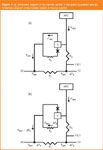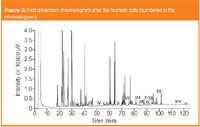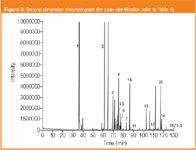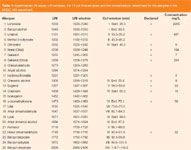Analysis of Allergens in Fragrances using Multiple Heart-cut Multidimensional Gas Chromatography–Mass Spectrometry
LCGC Europe
A total of fourteen cuts were defined because the retention time difference between several skin sensitizors was only slight.
The use of fragrances to generate pleasant and attractive smells in human bodies goes back thousands of years. These sample-types may be characterized by a considerable degree of complexity, as the number of natural and synthetic perfume formulation constituents in use is extremely high.1 The relationship between contact allergy and perfume ingredients has been widely discussed.2 Under a European regulation called the 7th Amendment of the Cosmetic Directive the twenty-six most frequently recognized skin allergens must be labelled on the final cosmetic product if specific concentrations are reached: 10 mg/L and 100 mg/L in "leave-on" and "rinse-off" substances respectively. Twenty-four of the twenty-six skin sensitizors are volatile and can, therefore, be analysed by GC.
Recently, a sample classification for the analysis of skin sensitizors was introduced: perfumes were included in class II, considering their medium to high complexity (commonly containing more than a hundred analytes). In these cases, a monodimensional gas chromatography (GC) application could be sufficient for satisfactory analyte determination. Whenever the complexity of a class II matrix exceeds the peak capacity of a single capillary column, then a multidimensional method must be used.3
Comprehensive multidimensional gas chromatography (GC×GC) has been used for the analysis of complex perfumes.3,4 It was demonstrated that a single peak eluting from the primary column consisted of eight overlapping components.4 In such a situation, the reliable determination of a fragrance ingredient by using any of the most common gas chromatogrpahy mass spectrometry (GC–MS) approaches — such as full scan monitoring, multi-ion chromatogram (MIC), single ion monitoring (SIM) or peak deconvolution — is an arduous task. Classical MDGC has also been used for the analysis of allergens contained in a fragrance.3 The target analytes were freed from co-eluting compounds through two 1 min heart cuts, performed on the perfume. The extensive degree of overlapping was evident in the second dimension chromatogram.
The research described in this article focuses on the use of an innovative valveless MDGC–MS system for the analysis of allergens in a complex perfume. The transfer device, which achieves two-dimensional (2D) analysis by pressure tuning at the column conjunction point, is simple to use and enables the transfer of multiple fractions during each application. Fourteen cuts were performed on the sample, with time windows determined using linear retention indices (LRIs).
Experimental
Sample and standard compounds: A commercial perfume was purchased from a local store in Messina, Italy. Amyl cinnamaldehyde, anisyl alcohol, benzyl alcohol, benzyl cinnamate, methyl 2-octynoate, citral, cinnamaldehyde, benzyl benzoate, benzyl salicylate, cinnamyl alcohol, amyl cinnamyl alcohol, coumarin, eugenol, isoeugenol, farnesol (four isomers with the Z,E and E,E isomers predominant), citronellol, geraniol, hydroxycitronellal, hexyl cinnamaldehyde, limonene, α-isomethylionone, lilial, linalool, lyral and and 1,4-dibromobenzene — the internal standard (IS) — were purchased from Sigma–Aldrich (Milan, Italy). The purity of each standard was verified and was accounted for prior to use, using GC–MS. A stock allergen solution (10000 mg/L) was prepared in ethanol and used for calibration purposes. Solutions containing all the 24 allergens were injected at different concentrations (from 1–10000 mg/L) considering their original purity.
A 1000 mg/L n-alkane mix (C7–C30) was purchased from Supelco (Bellefonte, Philadelphia, USA).
Instrumentation and operational conditions: The Shimadzu MDGC system consisted of two GC–2010 gas chromatographs (defined as GC 1 and GC 2), an MS-QP2010 quadrupole mass spectrometer and an AOC-20i autosampler (Shimadzu Corporation, Kyoto, Japan). GC 1 presents a split/splitless injector and a flame ionization detector (FID), while GC 2 presents a split/splitless injector (not used for MDGC analysis), a FID (not used for for this application) and a rapid scanning quadrupole mass spectrometer. The MDGC transfer device, located in GC 1, is connected to an advanced pressure control (APC) unit which supplies carrier gas (He), at constant pressure.
GC 1: An Equity-5MS (5% diphenyl + 95% polydimethylsiloxane) 30 m × 0.25 mm i.d. × 0.25 μm (Supelco) was used as column 1; an inlet head pressure of 100 kPa (He) was applied to the transfer device by means of an APC unit (PAPC); injection mode (280 °C): splitless (2 min); injection volume: 0.2 μL; carrier gas (He); Constant inlet head pressure (Pinl): 160 kPa; temperature programme: 40–260 °C at 1.5 °C/min; FID (280 °C); H2 flow: 50.0 mL/min; air flow: 400.0 mL/min; sampling rate: 80 msec.
GC 2: An Omegawax (100 % polyethylene glycol) 30 m × 0.25 mm i.d. × 0.25 μm (Supelco) was used as column 2; temperature programme: 40 °C (26 min) to 260 °C (8 min) at 1.5 °C/min. All data were collected by the GC Solution software (Shimadzu) for the FID (GC 1) and by the GC–MS solution software (Shimadzu) for the MS (GC 2). The allergens were identified by using the FFNSC 1.2 mass spectral library database (Shimadzu).
MS: Ion source: 200 °C; interface temp: 260 °C; interval scan: 40–400 m/z; scan speed: 2000 amu/s.
Results and Discussion
The heart of this innovative MDGC system consists of a simple transfer device for the rapid sequential re-injection of analyte "heart-cuts" from the first to the second dimension. The interface is thermally-stable, characterized by extremely reduced dead volumes and achieves analyte transfer through a Deans switching-type mechanism.5 Figure 1 reports two schemes of the transfer system device in the "stand-by" and "cut" position [Figure 1(a) and Figure 1(b) respectively]. In both configurations, the advanced pressure control (APC) supplies carrier gas at constant pressure (PAPC) to the external fused silica restrictor (defined as R3) and to the three-way solenoid valve (V). The latter is connected to two metallic branches, one with a fused silica restrictor (defined as R2) and one without. The R2 restrictor dimensions (length and internal diameter) generate a pressure drop (ΔP2) which is slightly lower than that relative to R3 (ΔP3).

Figure 1
When the electrovalve is not activated [Figure 1(a)], the APC pressure is reduced on the side of the first dimension (PAPC – ΔP3), meanwhile it is able to reach the second dimension branch, passing through the electrovalve, without changes (PAPC). In such a pressure configuration, the analytes from the first dimension are directed to FID 1. The system is switched to cut configuration [Figure 1(b)], by simply activating the valve. The first dimension branch pressure is the same as described previously (PAPC – ΔP3), while the second one is now PAPC – ΔP2, which, as discussed, is slightly lower than PAPC – ΔP3. In this instance, the first dimension flow is directed onto the secondary column. The FID 1 flame is maintained by a gas flow that derives from the APC unit.
Before a MDGC experiment it is of common to inject a target compound standard solution to define the heart-cut time windows. In the case of allergen solutions, it is well known that they are rather unstable and, hence, are characterized by a short life-time. A valid alternative was found: prior to the injection of a 100 mg/L allergen standard solution, a C7–C30 alkane mixture was subjected to "stand-by" MDGC analysis. Experimental LRIs were derived for each skin sensitizor on the first dimension 5% diphenyl column; LRI cut windows were established by applying a ±10 LRI unit value, with respect to the experimental LRI value (Table 1). Once an LRI-cut window was established it was easy to derive a time window for each target compound.
A total of fourteen cuts were defined because the retention time difference between several skin sensitizors was only slight. Through such an approach, the injection of an allergen solution before each multidimensional application (operational conditions may change in relation to the perfume complexity) would not be required: it would be only necessary to derive the LRIs through preliminary hydrocarbon analysis. It must be added that, as reported in the literature, LRI values calculated on a non-polar stationary phase are reproducible and may undergo only slight variations.6 Obviously, the allergen solutions would have to be injected for calibration curve construction, even though this would be done periodically and not on a daily basis.
A chromatogram relative to the first dimension perfume chromatogram, after heart-cutting (the position of each cut is visualized), is shown in Figure 2. It must be emphasized that the degree of retention time shift during multiple heart-cutting was neglectable. This negative effect occurs when the first dimension gas flow in the stand-by and cut modes are different. In this case the pressure drop in the primary column is always constant: Pinl – (PAPC – ΔP3).

Figure 2
The second dimension total ion chromatogram (TIC) for the MDGC–MS result is shown in Figure 3. It can be observed that twelve target analytes were determined, nicely separated from other matrix interferences; many of these compounds underwent significant co-elution with other perfume volatiles in monodimensional applications. The general mass spectral purity was very good, with MS library similarities always over 90%. Analyte concentrations versus extracted ion responses were also calculated, through the construction of four-point calibration curves, using serial dilutions of the stock standard solution with 1,4-dibromobenzene as the IS; regression coefficients were always over 0.9995. The extracted ions used were those advised by International Fragrance Association (IFRA).7

Figure 3
It must be added that only a single IS was employed because this eluted in the middle of the chromatogram (at approximately 72 min on the polar column). As can be observed from Table 1, the data derived is in good agreement with the labelled compounds. Four allergens (citronellol, geraniol, hydroxycitronellal, cinnamic alcohol), although reported on the label, were present in concentrations slightly lower than the limit. It is well known, though, that fragrance producers prefer to declare allergens in this type of situation.

Table 1: Experimental LRI values, LRI windows, the 14 cut time windows and the concentrations determined for the allergens in the MDGCâMS experiment.
Conclusions
The present research demonstrates the effectiveness and potential of a recently developed MDGC–MS system for the analysis of allergens in a complex perfume. The use of a twin-column system proved to be very useful in the elimination of matrix interferences. Furthermore, the addition of a third mass spectrometric dimension provided full structural elucidation for all compounds. Finally, the calculation of LRIs to define the cutting windows is a simple and effective procedure that can be applied generally.
Acknowledgments
We would like to thank Shimadzu Corporation and Supelco for the continuous support.
Luigi Mondello is a full professor of analytical chemistry at the University of Messina, Italy and at the "Campus Biomedico" in Rome. His research interests include chromatographic techniques and the development of coupled techniques and their applications in the study of natural complex matrices. His current roles include being a member of the scientific committee of the International Symposium on Capillary Chromatography, chairman of the 35th International Symposium on Essential Oils, editor of Flavour and Fragrance Journal (Wiley) and Journal of Separation Science.
Dr Alessandro Casilli is assistant professor in the Food Analysis Division at the School of Pharmacy of the University of Messina. His main interests regard the development of classical multidimensional and comprehensive chromatographic instrumentation in combination, particularly, with mass spectrometric detection.
Dr Peter Quinto Tranchida is assistant professor in the Food Analysis Division at the School of Pharmacy of the University of Messina. His main interests regard the development and application of fast GC methods, as well as classical multidimensional and comprehensive chromatographic techniques.
Dr Danilo Sciarrone is attending the third year of the PhD course in food chemistry and safety. His main interests regard multidimensional and comprehensive chromatographic techniques, such as LC×GC and MDGC, as well as fast GC–MS applications.
Paola Dugo is an associate professor of food chemistry at the University of Messina, Italy. Her research interests include the study of the composition of citrus essential oils and the study of components with possible biological activity in natural matrices by chromatographic techniques.
Giovanni Dugo is a full professor of food chemistry at the University of Messina, Italy. His main research interests cover the fields of food fats, citrus products and the development of innovative chromatographic techniques and methods for the study of complex matrices. He is a member of the Editorial Board of the Journal of Essential Oil research and of the "Rivista italiana di Scienza dell'Alimentazione" (Journal of Food Science and Nutrition) and chairman of the 35th International Symposium on Essential Oils.
References
1. D.H. Pybus and C.S. Sell, The Chemistry of Fragrances, (Royal Society of Chemistry, Cambridge, UK, 1999).
2. S.C. Rastogi, T. Menné and J. duus Johansen, Contact Dermatitis, 48(3),130–132 (2003).
3. F. David, C. Devos and P. Sandra, LCGC Europe, 19(11), 602–616 (2006).
4. L. Mondello et al., J. Chromatogr. A, 1067(1–2), 235–243 (2005).
5. D.R. Deans, Chromatographia, 1(1–2), 18–22 (1968).
6. F.R. Gonzales and A.M. Nardillo, J. Chromatogr. A, 842(1–2), 29–49 (1999).
7. Analytical procedure for the GC–MS quantification of potential fragrance allergens in fragrance compounds; version 1. Analytical Procedures (International Fragrance Association: Brussels, Belgium, 2003) pp 1–10.

Thermodynamic Insights into Organic Solvent Extraction for Chemical Analysis of Medical Devices
April 16th 2025A new study, published by a researcher from Chemical Characterization Solutions in Minnesota, explored a new approach for sample preparation for the chemical characterization of medical devices.
Sorbonne Researchers Develop Miniaturized GC Detector for VOC Analysis
April 16th 2025A team of scientists from the Paris university developed and optimized MAVERIC, a miniaturized and autonomous gas chromatography (GC) system coupled to a nano-gravimetric detector (NGD) based on a NEMS (nano-electromechanical-system) resonator.










